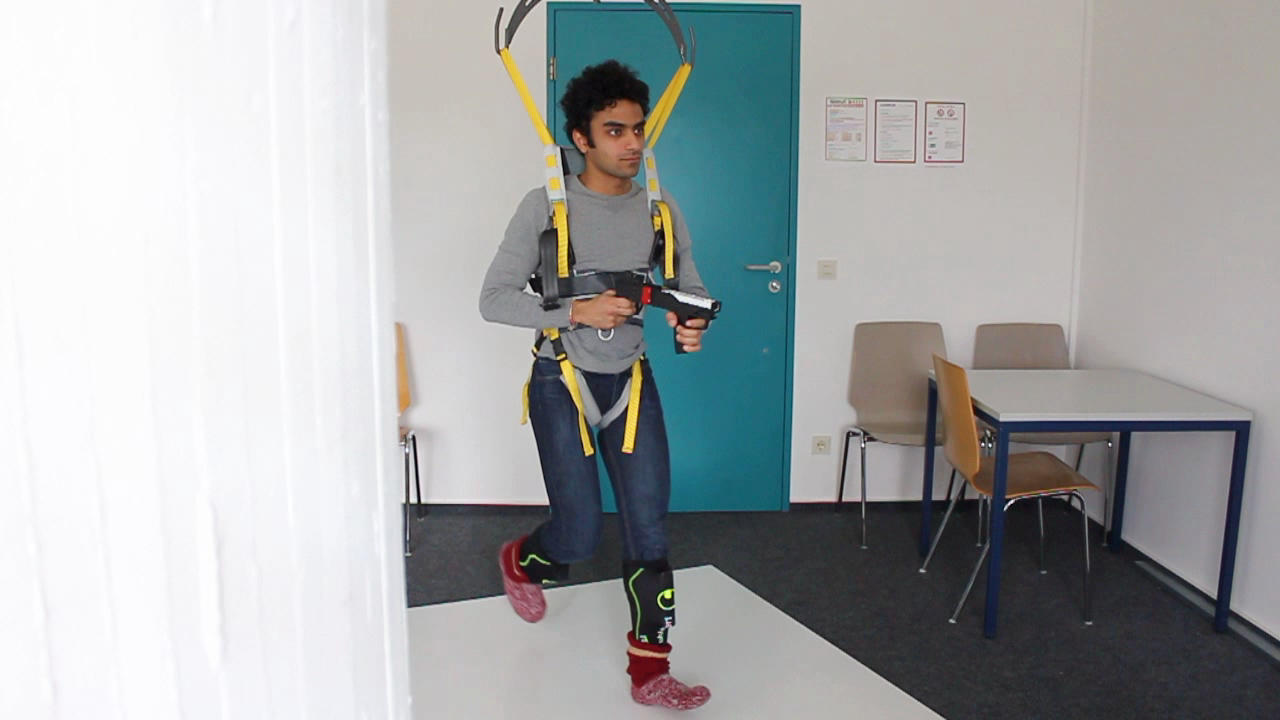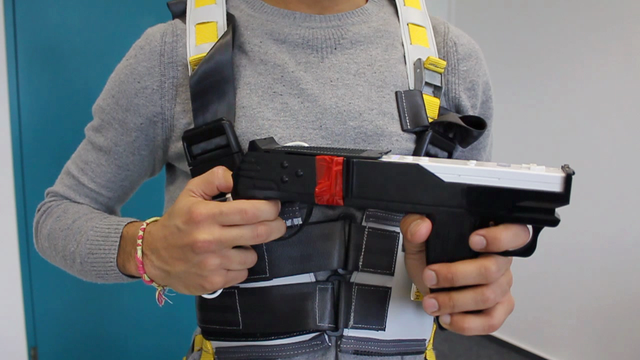Sportal
Exercise video games (exergames) can motivate players to be more physically active. Exercise My Game (XMG) is a design framework for turning off-the-shelf action games into full-body motion-based games.
Hoverboard: A Leap to the Future of Locomotion in VR!? Jan Smeddinck, Dmitry Alexandrovsky, Dirk Wenig, Michel Zimmer, Waldemar Wegele, Sylvia Juergens and Rainer Malaka
Locomotion in virtual reality (VR) remains challenging due to limitations of common input methods. Sedentary input devices may endanger immersion, real-to-virtual world perception dissonance can lead to simulator sickness, and physical input devices such as framed walking dishes are often complex and expensive. We present a low-cost, easy to use, easy to manufacture, and easily portable device for locomotion in VR based on a hoverboard metaphor. Building on related work and our own iterative VR locomotion system designs we hypothesize that hoverboarding can provide a compelling and intuitive method for short- and long-distance locomotion in VR with a potential to reduce simulator sickness due to consistent and stable locomotion that corresponds well to the physical proprioception of the users while navigating VR. We discuss design iterations of our device prototypes, promising results from an early explorative evaluation, as well as ongoing continued work.
Jan Smeddinck, Dmitry Alexandrovsky, Dirk Wenig, Michel Zimmer, Waldemar Wegele, Sylvia Juergens and Rainer Malaka (2017) Hoverboard: A Leap to the Future of Locomotion in VR!? In ICEC 2015: Proceedings of the 14th International Conference on Entertainment Computing. Lecture Notes in Computer Science 10507, 218-225. Springer, Berlin. 10.1007/978-3-319-66715-7_24 | BibTex
Exercise My Game: Turning Off-The-Shelf Games into Exergames Benjamin Walther-Franks, Dirk Wenig, Jan Smeddinck and Rainer Malaka
Exercise video games (exergames) can motivate players to be more physically active. However, most exergames are controlled by confined and predefined movements and do not promote long-term motivation. Well-funded commercial games often excel at long-term motivation, but are not operated with motion input. Exercise My Game (XMG) is a design framework for turning off-the-shelf action games into full-body motion-based games. Challenges with this approach involve finding mappings from control input to game-action, as well as blending active input feedback with the game’s interface. XMG facilitates transforming well-produced, non-exercise video games into captivating exergames by structuring the design space and outlining game requirements. We illustrate XMG with the example of turning the popular first-person action game Portal 2 into the exergame Sportal.
Benjamin Walther-Franks, Dirk Wenig, Jan Smeddinck and Rainer Malaka (2013) Exercise My Game: Turning Off-The-Shelf Games into Exergames In ICEC 2013: Proceedings of the 12th International Conference on Entertainment Computing. Lecture Notes in Computer Science 8215, 126-131. Springer, Berlin/Heidelberg. 10.1007/978-3-642-41106-9_15 | BibTex
Suspended Walking: A Physical Locomotion Interface for Virtual Reality Benjamin Walther-Franks, Dirk Wenig, Jan Smeddinck and Rainer Malaka
We present a novel physical locomotion interface for virtual environments. It suspends the user in a torso harness so that the feet just touch ground. Low friction materials allow walking motions with ground contact similar to real walking, while maintaining the user in the same position. We detail the hardware and motion tracking setup and outline results of a first user study.
Benjamin Walther-Franks, Dirk Wenig, Jan Smeddinck and Rainer Malaka (2013) Suspended Walking: A Physical Locomotion Interface for Virtual Reality In ICEC 2013: Proceedings of the 12th International Conference on Entertainment Computing. Lecture Notes in Computer Science 8215, 185-188. Springer, Berlin/Heidelberg. 10.1007/978-3-642-41106-9_27 | BibTex
Sportal: A First-Person Videogame turned Exergame Benjamin Walther-Franks, Dirk Wenig, Jan Smeddinck and Rainer Malaka
Digital exercise games (exergames) can motivate players to carry out physical exercises. However, most exergames are controlled by confined and predefined movements and do not promote long-term motivation. Well-funded commercial games often excel at long-term motivation, but are not operated with motion input. We choose the best of both worlds by turning an existing videogame without motion control into an exergame. By adding motion-based controls and a feedback overlay to the popular first- person action game Portal 2, and designing custom game levels around exercise regimens with the freely available Hammer editor, we turned it into the exergame Sportal. This approach can give gamers an incentive to exercise using high quality first-person gameplay and it can potentially acquaint exercise-eager non-gamers with a popular videogame title.
Benjamin Walther-Franks, Dirk Wenig, Jan Smeddinck and Rainer Malaka (2013) Sportal: A First-Person Videogame turned Exergame In M&C 2013, inter|aktion - Demosession: Mensch & Computer Workshopband: Interaktive Vielfalt, 543-546. Oldenbourg Verlag, München. | BibTex




